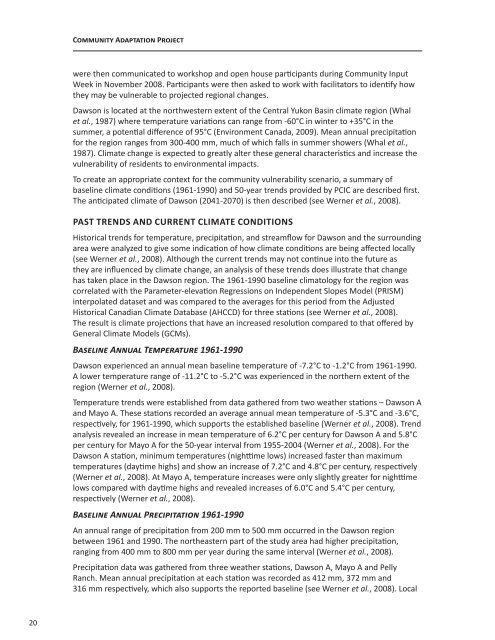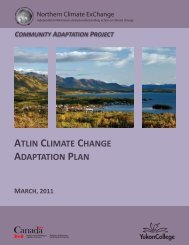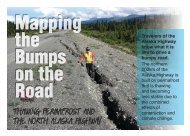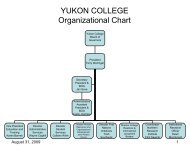Dawson Climate Change Adaptation Plan, Revised ... - Yukon College
Dawson Climate Change Adaptation Plan, Revised ... - Yukon College
Dawson Climate Change Adaptation Plan, Revised ... - Yukon College
Create successful ePaper yourself
Turn your PDF publications into a flip-book with our unique Google optimized e-Paper software.
Community <strong>Adaptation</strong> Projectwere then communicated to workshop and open house participants during Community InputWeek in November 2008. Participants were then asked to work with facilitators to identify howthey may be vulnerable to projected regional changes.<strong>Dawson</strong> is located at the northwestern extent of the Central <strong>Yukon</strong> Basin climate region (Whalet al., 1987) where temperature variations can range from -60°C in winter to +35°C in thesummer, a potential difference of 95°C (Environment Canada, 2009). Mean annual precipitationfor the region ranges from 300-400 mm, much of which falls in summer showers (Whal et al.,1987). <strong>Climate</strong> change is expected to greatly alter these general characteristics and increase thevulnerability of residents to environmental impacts.To create an appropriate context for the community vulnerability scenario, a summary ofbaseline climate conditions (1961-1990) and 50-year trends provided by PCIC are described first.The anticipated climate of <strong>Dawson</strong> (2041-2070) is then described (see Werner et al., 2008).PAST TRENDS AND CURRENT CLIMATE CONDITIONSHistorical trends for temperature, precipitation, and streamflow for <strong>Dawson</strong> and the surroundingarea were analyzed to give some indication of how climate conditions are being affected locally(see Werner et al., 2008). Although the current trends may not continue into the future asthey are influenced by climate change, an analysis of these trends does illustrate that changehas taken place in the <strong>Dawson</strong> region. The 1961-1990 baseline climatology for the region wascorrelated with the Parameter-elevation Regressions on Independent Slopes Model (PRISM)interpolated dataset and was compared to the averages for this period from the AdjustedHistorical Canadian <strong>Climate</strong> Database (AHCCD) for three stations (see Werner et al., 2008).The result is climate projections that have an increased resolution compared to that offered byGeneral <strong>Climate</strong> Models (GCMs).Baseline Annual Temperature 1961-1990<strong>Dawson</strong> experienced an annual mean baseline temperature of -7.2°C to -1.2°C from 1961-1990.A lower temperature range of -11.2°C to -5.2°C was experienced in the northern extent of theregion (Werner et al., 2008).Temperature trends were established from data gathered from two weather stations – <strong>Dawson</strong> Aand Mayo A. These stations recorded an average annual mean temperature of -5.3°C and -3.6°C,respectively, for 1961-1990, which supports the established baseline (Werner et al., 2008). Trendanalysis revealed an increase in mean temperature of 6.2°C per century for <strong>Dawson</strong> A and 5.8°Cper century for Mayo A for the 50-year interval from 1955-2004 (Werner et al., 2008). For the<strong>Dawson</strong> A station, minimum temperatures (nighttime lows) increased faster than maximumtemperatures (daytime highs) and show an increase of 7.2°C and 4.8°C per century, respectively(Werner et al., 2008). At Mayo A, temperature increases were only slightly greater for nighttimelows compared with daytime highs and revealed increases of 6.0°C and 5.4°C per century,respectively (Werner et al., 2008).Baseline Annual Precipitation 1961-1990An annual range of precipitation from 200 mm to 500 mm occurred in the <strong>Dawson</strong> regionbetween 1961 and 1990. The northeastern part of the study area had higher precipitation,ranging from 400 mm to 800 mm per year during the same interval (Werner et al., 2008).Precipitation data was gathered from three weather stations, <strong>Dawson</strong> A, Mayo A and PellyRanch. Mean annual precipitation at each station was recorded as 412 mm, 372 mm and316 mm respectively, which also supports the reported baseline (see Werner et al., 2008). Local20













